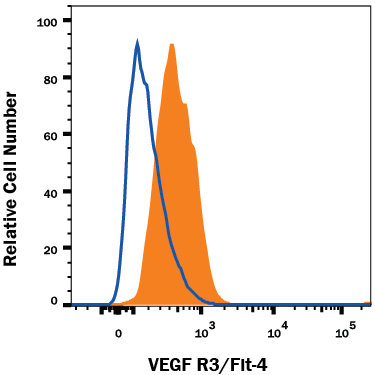Human VEGFR3/Flt-4 PE-conjugated Antibody Summary
Tyr25-Ile776
Accession # P35916
Applications
Please Note: Optimal dilutions should be determined by each laboratory for each application. General Protocols are available in the Technical Information section on our website.
Scientific Data
 View Larger
View Larger
Detection of VEGF R3/Flt‑4 in HUVEC Human Cells by Flow Cytometry. HUVEC human umbilical vein endothelial cells were stained with Mouse Anti-Human VEGF R3/ Flt-4 PE-conjugated Monoclonal Antibody (Catalog # FAB3492P, filled histogram) or isotype control antibody (Catalog # IC002P, open histogram). View our protocol for Staining Membrane-associated Proteins.
Reconstitution Calculator
Preparation and Storage
- 12 months from date of receipt, 2 to 8 °C as supplied.
Background: VEGFR3/Flt-4
VEGF R2 (KDR/Flk-1), VEGF R1 (Flt-1) and VEGF R3 (Flt-4) belong to the class III subfamily of receptor tyrosine kinases (RTKs). All three receptors contain seven immunoglobulin-like repeats in their extracellular domains and kinase insert domains in their intracellular regions. The expression of VEGF R1, 2, and 3 is almost exclusively restricted to the endothelial cells. These receptors are likely to play essential roles in vasculogenesis and angiogenesis.
VEGF R3 cDNA encodes a 1298 amino acid (aa) residue precursor protein with a 24 aa residue signal peptide. Mature VEGF R3 is composed of a 751 aa residue extracellular domain, a 22 aa residue transmembrane domain, and a 482 aa residue cytoplasmic domain. Both VEGF-C and VEGF-D have been shown to bind and activate VEGF R3 (Flt-4). VEGF R3 is widely expressed in the early embryo but becomes restricted to lymphatic endothelia at later stages of development. It is likely that VEGF R3 may be important for lymph angiogenesis.
Product Datasheets
Citations for Human VEGFR3/Flt-4 PE-conjugated Antibody
R&D Systems personnel manually curate a database that contains references using R&D Systems products. The data collected includes not only links to publications in PubMed, but also provides information about sample types, species, and experimental conditions.
7
Citations: Showing 1 - 7
Filter your results:
Filter by:
-
BRAF Inhibition Stimulates Melanoma-Associated Macrophages to Drive Tumor Growth.
Authors: Wang T, Xiao M, Ge Y, Krepler C, Belser E, Lopez-Coral A, Xu X, Zhang G, Azuma R, Liu Q, Liu R, Li L, Amaravadi R, Xu W, Karakousis G, Gangadhar T, Schuchter L, Lieu M, Khare S, Halloran M, Herlyn M, Kaufman R
Clin Cancer Res, 2015-01-23;21(7):1652-64.
Species: Human
Sample Types: Whole Cells
Applications: Flow Cytometry -
Differential sensitivity of prostate tumor derived endothelial cells to sorafenib and sunitinib.
Authors: Fiorio Pla, Alessand, Brossa, Alessia, Bernardini, Michela, Genova, Tullio, Grolez, Guillaum, Villers, Arnaud, Leroy, Xavier, Prevarskaya, Natalia, Gkika, Dimitra, Bussolati, Benedett
BMC Cancer, 2014-12-12;14(0):939.
Species: Human
Sample Types: Whole Cells
Applications: Flow Cytometry -
Expression of VEGF receptors on endothelial cells in mouse skeletal muscle.
Authors: Imoukhuede, Princess, Popel, Aleksand
PLoS ONE, 2012-09-12;7(9):e44791.
Species: Mouse
Sample Types: Whole Cells
Applications: Flow Cytometry -
Highly efficient and feeder-free production of subculturable vascular endothelial cells from primate embryonic stem cells.
Authors: Saeki K, Yogiashi Y, Nakahara M, Nakamura N, Matsuyama S, Koyanagi A, Yagita H, Koyanagi M, Kondo Y, Yuo A
J. Cell. Physiol., 2008-10-01;217(1):261-80.
Species: Primate - Macaca fascicularis (Crab-eating Monkey or Cynomolgus Macaque)
Sample Types: Whole Cells
Applications: Flow Cytometry -
Tumor necrosis factor-alpha and endothelial cells modulate Notch signaling in the bone marrow microenvironment during inflammation.
Authors: Fernandez L, Rodriguez S, Huang H, Chora A, Fernandes J, Mumaw C, Cruz E, Pollok K, Cristina F, Price JE, Ferkowicz MJ, Scadden DT, Clauss M, Cardoso AA, Carlesso N
Exp. Hematol., 2008-05-01;36(5):545-558.
Species: Human
Sample Types: Whole Cells
Applications: Flow Cytometry -
Notch alters VEGF responsiveness in human and murine endothelial cells by direct regulation of VEGFR-3 expression.
Authors: Shawber CJ, Funahashi Y, Francisco E, Vorontchikhina M, Kitamura Y, Stowell SA, Borisenko V, Feirt N, Podgrabinska S, Shiraishi K, Chawengsaksophak K, Rossant J, Accili D, Skobe M, Kitajewski J
J. Clin. Invest., 2007-11-01;117(11):3369-82.
Species: Human
Sample Types: Whole Cells
Applications: Flow Cytometry -
Vascular endothelial growth factor can signal through platelet-derived growth factor receptors.
Authors: Ball SG, Shuttleworth CA, Kielty CM
J. Cell Biol., 2007-04-30;177(3):489-500.
Species: Human
Sample Types: Whole Cells
Applications: Flow Cytometry
FAQs
No product specific FAQs exist for this product, however you may
View all Antibody FAQsReviews for Human VEGFR3/Flt-4 PE-conjugated Antibody
There are currently no reviews for this product. Be the first to review Human VEGFR3/Flt-4 PE-conjugated Antibody and earn rewards!
Have you used Human VEGFR3/Flt-4 PE-conjugated Antibody?
Submit a review and receive an Amazon gift card.
$25/€18/£15/$25CAN/¥75 Yuan/¥2500 Yen for a review with an image
$10/€7/£6/$10 CAD/¥70 Yuan/¥1110 Yen for a review without an image




